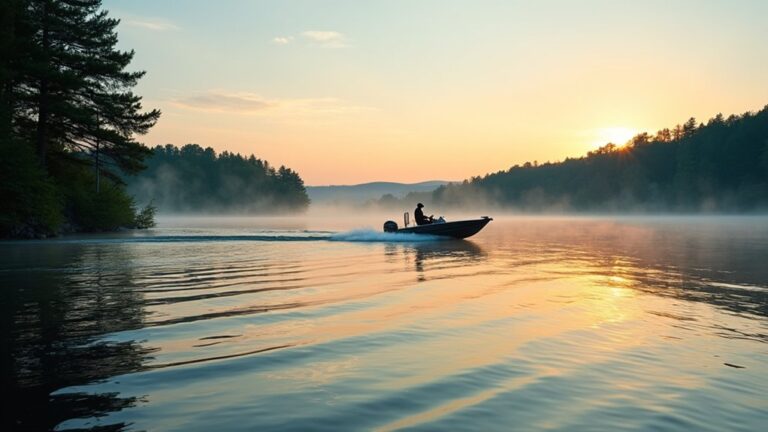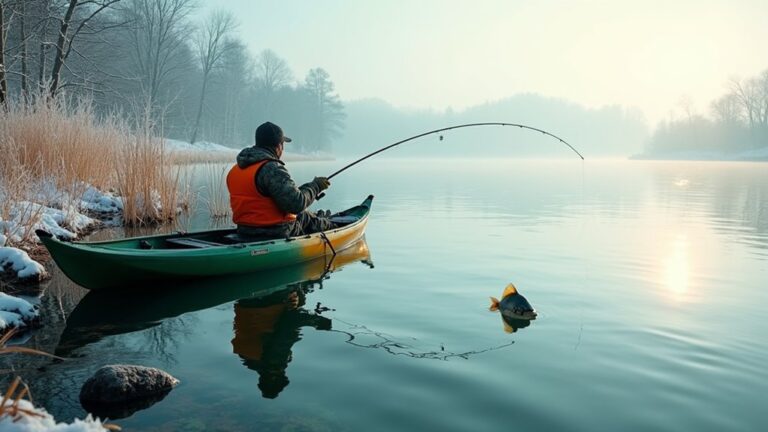Bass species originally inhabited distinct regions of North America – Largemouth in the southeastern U.S. and Great Lakes, Smallmouth in the St. Lawrence system, Florida Bass in Florida's waters, and Guadalupe Bass in Texas rivers. You'll find that human intervention in the late 19th century dramatically expanded their range, with Largemouth Bass now present in 34 U.S. states and over 70 countries worldwide. Each species has adapted to various environmental conditions, revealing fascinating details about their evolution and distribution.
Native Geographic Origins of Bass Species
While bass species are now found across North America, their native ranges were far more limited. You'll find that the Largemouth Bass originally inhabited the southeastern coastal United States, including the Great Lakes region.
The Smallmouth Bass's native range centered around the cooler waters of the St. Lawrence River and Great Lakes systems.
When exploring black bass species, you'll discover that some have very specific original ranges. The Florida Bass evolved exclusively in Florida's waters, while the Guadalupe Bass calls Texas river systems its native home.
The Alabama Bass represents another geographically specific species, originating in the Mobile River system. These distinct native ranges have played a vital role in shaping each species' characteristics and adaptations to their local environments. Understanding bass behavior can also provide insights into how these species interact with their habitats.
Early Population Patterns and Movement
During the late 19th century, Largemouth Bass populations underwent a dramatic expansion beyond their native Great Lakes and Mississippi Basin ranges.
You'll find that their historical patterns of movement began with early introductions along the southern Atlantic Coastal Plain, followed by successful establishments in Oregon by 1888 and California by 1910. The species' range quickly expanded to include verified populations in major northeastern rivers, with documented specimens in the James River as early as 1867.
The introduced populations didn't stop at continental borders. Hawaii received its first Largemouth Bass in 1897, leading to established populations across all main islands.
Today, you can find these fish in 34 US states and more than 70 countries worldwide, though their competition with native species has created significant ecological impacts in many regions.
Human-Driven Range Expansion

Since the late 19th century, human interventions have transformed Largemouth Bass from a regional species into a global presence. You'll find this widely introduced fish in 34 U.S. states and 70 countries worldwide, far beyond its original Great Lakes and Mississippi basins range. The species' expansion has raised ecological concerns, particularly threatening native fish communities and causing hybridization with species like the Alabama Bass. Effective fishing techniques and understanding optimal fishing conditions can sometimes lead to increased competition with native species.
| Region | Introduction Timeline |
|---|---|
| California | 1891-1910 |
| Hawaii | 1897-Present |
| British Columbia | Late 1800s |
| Puerto Rico | Mid-1900s |
| Europe/Asia | Late 1900s |
This human-driven range expansion continues to challenge conservation efforts as Largemouth Bass establish themselves in various aquatic ecosystems, demonstrating both the species' adaptability and the far-reaching consequences of intentional fish introductions.
Environmental Factors Shaping Distribution
The widespread presence of Largemouth Bass across diverse ecosystems stems not only from human introductions but also from specific environmental conditions that enable their survival.
You'll find these fish thriving in waters where temperatures range from 26-28°C, and they can handle salinity levels up to 12.9 PSU. Their habitat preferences include clear, vegetated lakes, ponds, and rivers, with a particular affinity for areas that offer suitable spawning sites.
As an introduced species, Largemouth Bass have markedly impacted native fish communities wherever they've been stocked.
Environmental factors like water temperature, dissolved oxygen, and available vegetation continue to shape their distribution patterns. You can observe this particularly in eastern Canada, where climate change has shifted their northern range boundaries, demonstrating how these fish adapt to changing conditions.
Regional Adaptations and Genetic Variations

Genetic diversity within bass species reveals a complex tapestry of regional adaptations across North America.
You'll find notable genetic distinctions within the Largemouth Bass, particularly with the Florida Largemouth Bass showing enhanced growth and longevity. The Alabama Bass's establishment in California demonstrates how black bass species can adapt to new environments while maintaining unique genetic variations.
Key genetic impacts on bass populations include:
- Hybridization between introduced Largemouth Bass and native species
- Regional adaptations affecting growth rates and survival
- Distinct genetic markers within the Micropterus genus
- Population variations influencing conservation efforts
These genetic differences have shaped conservation strategies, especially where hybridization threatens native populations.
Understanding these variations has become essential for managing and preserving distinct bass species across different regions.
Impact of Climate Change on Bass Range
Regional adaptations that have shaped bass populations are now facing unprecedented challenges from climate change. You'll find Largemouth Bass expanding their range northward as water temperatures rise across eastern Canada and the northern United States.
These warming conditions aren't just affecting their distribution – they're also accelerating growth rates and triggering earlier spawning events.
Climate change is reshaping bass habitats through altered precipitation patterns and extreme weather events, which destabilize water levels in freshwater ecosystems.
You're likely to see shifts in competitive dynamics between bass species as thermal regimes change. Adding to these challenges, invasive species like the Alabama Bass are complicating matters for native populations.
Their presence increases the risk of hybridization and genetic dilution, further transforming the traditional range and distribution patterns of bass species.
Current Distribution Mapping and Tracking
Modern mapping technologies have revolutionized our understanding of Largemouth Bass distribution across North America and beyond.
You'll find established populations in 34 US states and 5 Canadian provinces, with their historical range now extending into Mexico and Central America.
Distribution tracking shows they're particularly abundant in Delta region's tidal freshwaters, where they've flourished since the early 2000s.
Key findings from current distribution mapping reveal:
- A significant northward range shift in eastern Canada due to climate change
- Successful establishment across all main Hawaiian islands
- Increased competition with native fish species in introduced areas
- Notable ecological impacts on local fish populations
These tracking efforts help scientists better understand the species' spread and its effects on various ecosystems they've been introduced to.
Management Strategies for Population Control
While managing bass populations requires a multi-faceted approach, wildlife agencies have developed effective control strategies that balance conservation with recreational fishing interests.
You'll find that fisheries managers implement these strategies through regulated seasons and size limits to guarantee sustainable harvest of Largemouth Bass populations.
Habitat restoration projects focus on improving water quality and spawning areas, which enhance population dynamics for both native species and sport fish.
To combat invasive impacts, you can observe how managers use strategic stocking programs that boost local biodiversity.
Monitoring programs rely on your fishing reports combined with scientific surveys to track population health.
Through coordinated efforts between state and federal agencies, you'll see how recreational fishing opportunities are preserved while protecting the ecosystem's balance through carefully planned conservation measures. Additionally, the choice of rod power and action can significantly influence the effectiveness of these management strategies by providing anglers with the tools needed to adhere to regulations.
Frequently Asked Questions
What Is the Native Range of Bass?
You'll find native bass species primarily in eastern North America, from the St. Lawrence River through the Great Lakes and Mississippi Basin, extending south to Florida and Texas, with distinct species in specific regions.
Where Are Bass Originally From?
You'll find that bass originally came from eastern North America, with Largemouth Bass native to the Great Lakes and Mississippi basins, while Smallmouth Bass originated in the St. Lawrence River-Great Lakes system.
Are Largemouth Bass in All 50 States?
No, you won't find largemouth bass in Alaska, though they're present in all other 49 states, including Hawaii. They've been successfully introduced across the continental U.S. and established thriving populations in most waters.
What Ranges Are Bass?
You'll find bass species across North America, with largemouth in 48 states, smallmouth in cooler northern waters, and specialized species like Guadalupe and Alabama bass in more limited southeastern regions.
Final Thoughts
You've learned how bass species have dramatically expanded beyond their native ranges through both natural adaptation and human introduction. As you track current populations, you'll notice how climate change continues to alter their distribution patterns. Understanding these historical movements and genetic variations will help you make better management decisions to maintain healthy bass populations while protecting local ecosystems from invasive impacts.




